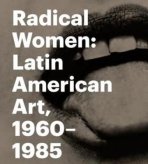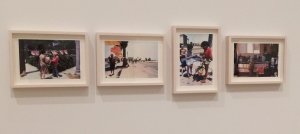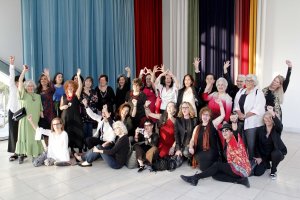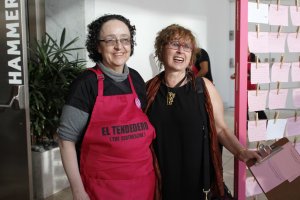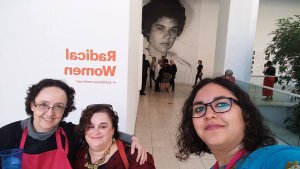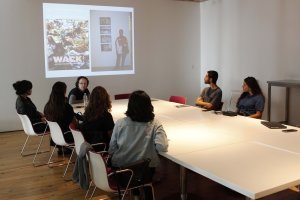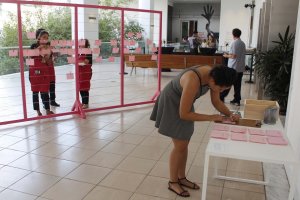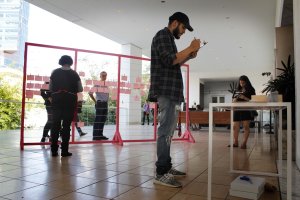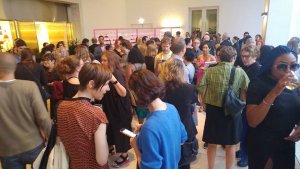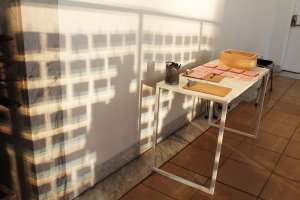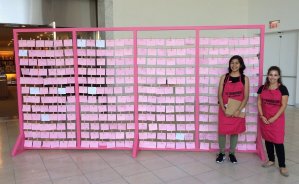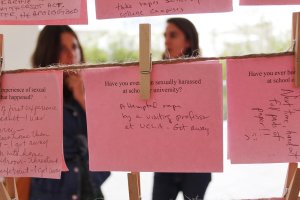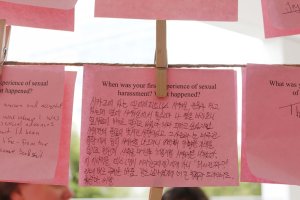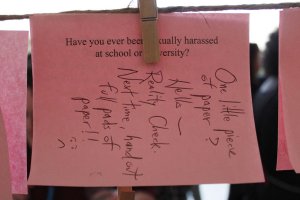Photo: Yuruen Lerma
I started reactivating the piece in 2009, when I was invited to the exhibition Sin Centenario ni Bicentenario at the Universidad Iberoamericana in Mexico City, which dealt with the invisibility of women in the upcoming celebrations of the bicentennial anniversary of the Independence and the centennial anniversary of our Revolution in Mexico, both in 2010. Since then, the piece has been reactivated by myself and by others nonstop. You can find more information on many of the different Tendederos I have activated in different countries at my webpage El Tendedero. https://www.el-tendedero.pintomiraya.com/index.php/70-s/item/5-el-primer-tendedero
The second iteration in the United States was also in Los Angeles, in 2017, during the Radical Women: Latin American Art 1960-1985 https://hammer.ucla.edu/radical-women exhibition at the Hammer Museum, which included several pieces of mine, among them documentation of El Tendedero I did in 1979 for Suzane Lacy’s Making it Safe Project. I was also invited to reactivate the piece.
The Exhibition
Cecilia Fajardo-Hill and Andrea Giunta curated this splendid exhibition that brought together the works of more than 100 Latin American women artists from 15 countries, focusing on the body, its performativity, political presence, and eroticism.
The exhibition was developed over approximately 8 years, most of which were dedicated to researching the work of many artists, including well-known figures like Ana Mendieta and Marta Minujín, as well as others overlooked by contemporary art narratives, such as Ana Victoria Jiménez. This was one of those exhibitions that transform history, much like WACK! Art and the Feminist Revolution, organized in 2008 by Connie Butler, the chief curator at the Hammer during the Radical Women exhibition. Although I have studied and written about women artists for years, I was not familiar with many of my Latin American colleagues, or I had only heard of them but had not seen their work. Information does not always flow well between our countries.
Photos: Yuruen Lerma
You can imagine how excited I was, like a kid in a candy store. I went through the exhibition eighty times, and each time I discovered something new. But the most wonderful part was that 40 of the artists attended the opening.
From left to right: Magali Lara, Graciela Carnevali, Mónica Mayer, and Andrea Giunta. Photo: Yuruen Lerma
As always, it gave me great pleasure to greet Graciela Carnevale and Judy Baca, both of whom I greatly admire. I also loved meeting María Evelia Marmolejo in person because we were already Facebook friends, and it was the first time I had a conversation with the Chilean artist Janet Toro, whose work moved me deeply.
With Sandra Isabel Llano. Photo: Yuruen Lerma
Colombian artist Sandra Isabel Llano, with whom I studied at art school in Mexico in the 70s and hadn't seen in years, also attended. It was wonderful to see her again.
Part of the exhibition’s parallel activities was the symposium "The Political Body in Latina and Latin American Art" and I had the pleasure of participating. You can see it here. https://livestream.com/hammermuseum/events/7690234/videos/162983989
And here's a review of the symposium by Jeri Finkel for The Art Newspaper. The photo is also by Finkel. https://www.theartnewspaper.com/2017/09/20/psts-radical-women-speak-out-in-day-long-symposium-at-hammer-museum
And don't miss the catalog, which includes texts by the curators and authors such as Carmen María Jaramillo, Rodrigo Alonso, and Rosina Cazali.
From left to right: Mónica Mayer, Karen Cordero and Yuruen Lerma. Photo: Yuruen Lerma.
Karen Cordero wrote for the catalogue about Mexican women artists, and Julia Antivilo (Chile), María Laura Rosa (Argentina), and I contributed with a collaborative text on feminist art in Latin America.
Here's a catalog review by Gillian Sneed. https://brooklynrail.org/2017/12/art_books/Radical-Women-Latin-American-Art-1960-1985-Dec-Jan
Photo: Yuruen Lerma.
The volunteers also walked around the exhibition rooms to get responses. Here are two persons filling out the pink slips in front of one of my works at the exhibition.
The Radical Women Tendedero
Several of my works were presented in the exhibition (Lo Normal, documentation of El Tendedero de L.A., and A veces me espantan mis fantasias (Sometimes My Fantasies Frighten Me) as well as works from Polvo de Gallina Negra (Black Hen’s Dust), the feminist art group that Maris Bustamante and I founded in the early 1980s. There were two videos from the ¡MADRES! (MOTHERS!) project and Receta para causarle el mal de ojo a los violadores o el respeto al derecho del cuerpo ajeno es la paz (Recipe to Cause Rapists the Evil Eye or Respect for the Rights of Other Bodies Is Peace) by Polvo de Gallina Negra. [1]
Although this was not my first Tendedero, which was in Mexico city, I thought it was very appropriate to exhibit El Tendedero L.A. / The L.A. Clothesline in the same city, almost thirty years later, because the piece exemplifies the connections between feminist artists from Mexico and the United States. As I mentioned, I was also asked to reactivate the piece for the exhibitions opening days.
Due to time and distance constraints, this Tendedero was a bit different.
The curators and I defined the questions in advance, which were in English and Spanish. They were:
What would make you feel safer as a woman in Los Angeles?
When was the first time you experienced sexual harassment?
Have you experienced harassment at school or university?
What is your most recent experience of sexual harassment?
Photo: Yuruen Lerma
El Tendedero was placed on the hallway and the museum recruited a group of volunteers, mostly students, who activated the piece throughout the day and invited the public to participate. Before their shifts, I would meet with each group and provide a brief explanation of the piece and how to approach the public. The volunteers were Divana Olivas, Chloe Landis, Michelle Kim, Angel King, Clara Vara Escamilla, Lucy Sánchez, Vanessa Guzmán, Gabriela Mesa, Belen Moreno, Ji soo Chung, Iván Hernández, Emily Nelms Pérez, Emmanuel Gálvez, Marilyn Castillo, Anushka Sapra, and Carissa Mosley.
Photos: Yuruen Lerma
The first group went out into the street to gather responses and met total resistance. Although I knew many people would attend the opening and the symposium because they were among the most important events of the enormous Pacific Standard Time LA/LA project by the Getty Foundation, at first, I thought we would not be able to fill El Tendedero because it required at least 600 answers.
With Cecilia Fajardo-Hill
I had nothing to worry about. Nearly three thousand persons attended the opening, and many of them participated in the piece. It filled up that same night. Sadly, the stories in Los Angeles are just as terrible as those in Mexico.
Photo: Yuruen Lerma
This is a small text I wrote for Facebook about the opening:
The official opening of Radical Women was sensational. I finally met many Latin American artists whom I admire and greeted others I already knew and love. My dear friends Karen Cordero, Magali Lara, Ximena Cuevas, and Lourdes Grobet from Mexico were there, as well as Cecilia Fajardo-Hill and Andrea Giunta, the tenacious and talented curators who made this exhibition possible, and the wonderful Connie Butler. Thousands of people attended, and there were queues waiting to enter a free-entry museum that they could visit any other time. It seems that, apart from the exhibition itself, it was politically important to support it. I saw friends from my time at the Woman's Building, journalists and critics, colleagues from Mexico, curators and academics from various continents and generations, artist friends from LA, high-ranking Mexican officials, gallery owners from well-known spaces and alternative venues, and collectors whose names one only reads about. El Tendedero filled up with answers despite the rush of the night, and people continued to participate even after the volunteers activating the piece had left. But for me, the most beautiful thing was that I could share this important moment with my daughter Yuruen Lerma.
Photo: Yuruen Lerma
By the time it was taken down, there were answers on both sides of El Tendedero.
Photos Mónica Mayer
These are some of the answers from this Tendedero.
The volunteers wrote their experiences working on the Tendedero on white pieces of paper.
We had answers in several languages.
Photos: Yuruen Lerma
[1] The title of this piece plays with the famous phrase by President Benito Juárez in 1867: Between individuals, as between nations, respect for the rights of others is peace.


